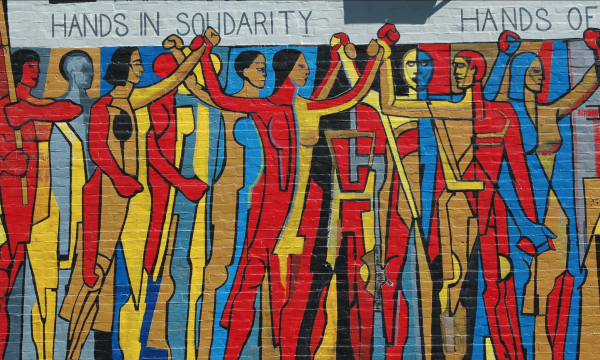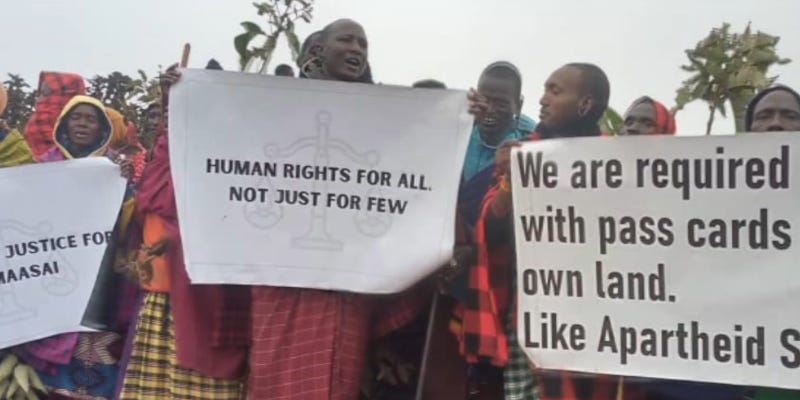
Fourteen values-aligned organizations have formed the Movement Media Alliance, a new coalition of social justice-driven journalism platforms aimed at sharing resources and transforming the news.Last November, 25 media-makers from 15 independent U.S.-based organizations came together around a long table at Chicago’s Haymarket House to talk about the future of media and how we might build it together.
Although our organizations differed in focus, audience, size, perspective and origin, we all believed in the power of media to inform and fuel social movements that transform the world. Many of us embraced the concept of movement journalism, defined by Project South as “the practice of journalism in the service of … social, political and economic transformation.” We gathered together to explore a pressing question: During these desperately urgent times, how can we work collaboratively to sharpen and grow the practice of movement journalism?
Our publications convened amid cataclysmic changes in the broader media universe — and more have transpired since. Over the past year, we’ve seen a flood of recent shutdowns (from Buzzfeed News to The Messenger and more), layoffs (including at legacy outlets like The Washington Post, Los Angeles Times and Wall Street Journal), bankruptcies (most notably Vice) and near-deaths and acquisitions (such as Sports Illustrated and Jezebel). The media landscape is also shrinking. A Medill analysis recently found, “The loss of local newspapers accelerated in 2023 to an average of 2.5 per week.”
Meanwhile, recent events — including Israel’s genocide against Palestine, the repression of protest, the flourishing of MAGA politics, continued environmental destruction and the intensification of anti-trans policy, to name a few — have exposed how mainstream media often fuel grave political harm by platforming and showing deference to the perpetrators of these injustices.
When our journalism organizations met in November 2023, we had originally planned to focus on covering the 2024 election. Instead, we pivoted because an emergency was at hand: the U.S. government’s support of Israel’s genocide against Gaza and the ways our corporate media outlets were — especially in those early days — bolstering genocidal rhetoric and minimizing the extent of the atrocities.Over two days, we built the collaboration that became Media Against Apartheid and Displacement, a centralized and curated media hub that aggregates articles from trustworthy, independent news sources reporting on the ongoing genocide against — and occupation of — Palestine, the international complicity that props up that genocide and occupation, and the rising global movements for Palestinian liberation. MAAD also gathers media focused on settler colonialism, apartheid, genocide, state violence, surveillance, displacement and occupation worldwide, elevating ideas and insights that point the way toward a liberated future. After our convening at Haymarket House, we reached out to more organizations to build with. MAAD collaborating publications now include Prism, Truthout, In These Times, Mondoweiss, Palestine Square, Haymarket Books, The Real News Network, The Forge, Waging Nonviolence, The Dig, The Kansas City Defender, Briarpatch, Baltimore Beat, Hammer & Hope, Scalawag, Convergence Magazine and Analyst News.
MAAD does what none of our publications can do alone: It provides an extensive range of information and analysis on one of the key issues of our time, with each organization contributing an essential piece of the puzzle so that together we can write a thorough first draft of this history. More broadly, MAAD represents an unprecedented coalition. Beyond individual journalists, we are media organizations uniting to say, “We refuse to participate in the journalistic status quo. We choose truth.”
Throughout the winter and spring, our organizations worked together in stops and starts, through Slack channels and texts and laughter and chaos. We even met each other’s cats on Zoom. We couldn’t believe we hadn’t gotten to know each other before. Through our work together, we recognized an essential and oft-forgotten truth: We can’t make long-term journalistic change alone.
MAAD is just one example of what we can do when we come together: We can meet emergencies with real strength. Our individual outlets may be small relative to the largest corporate media, but together we’re formidable — able to more powerfully advance social and political transformation.
In June, many of our movement media organizations convened again. Together, we began work on Communities Beyond Elections, a forthcoming collaborative feature that will look at the impact of electoral politics on a range of oppressed groups, and will delve into how these communities are building liberatory futures inside and beyond those political realms. We made plans for covering the Republican and Democratic National Conventions. And perhaps most importantly, we embarked on a groundbreaking discussion of how our independent, non-corporate news organizations could collaborate to support each other financially, with the knowledge that a vibrant, varied, sustainable movement journalism ecosystem benefits us all.
We made a big decision: to launch the Movement Media Alliance, or MMA, a coalition of grassroots-aligned, social justice-driven journalism organizations committed to accurate, transparent, accountable, principled and just media. The MMA officially launches today, as we dedicate ourselves to working collaboratively to amplify our impact and sustain our work. Our members include Truthout, Prism, In These Times, Convergence, Waging Nonviolence, Scalawag, Inquest, The Real News Network, Baltimore Beat, Palestine Square, Respair Production & Media, The Forge and Haymarket Books.
In connecting with each other, we’ve come to recognize more palpably that our individual outlets can’t afford to blithely compete under capitalist frameworks. We can’t survive by simply going for clickbait, or conforming to mainstream media’s more palatable priorities in order to bring in revenue. We also can’t afford to abandon democracy — and oppressed communities — by simply letting our publications die.
Instead, we’re building power together.
There is power in creating movement journalism in a landscape where readers, viewers and listeners feel abandoned or unseen by traditional media. Movement journalism offers a critical tool for communities to learn, make informed decisions, expand their solidarities and share solutions for the issues that affect their lives. It inspires, shapes and sustains social movements.
Much like MAAD, which is an unprecedented show of solidarity and power from 18 different platforms to uplift accurate news and analysis on settler-colonial atrocities, we are building the Movement Media Alliance during a critical time. We take inspiration from values-driven media coalitions like the Media Consortium, which sunsetted in 2019, and Press On, a Southern media collective for movement journalists. We recognize the importance of working with editors, reporters, producers and storytellers across the country toward social justice. We share a vision that eschews outdated and white supremacist notions of “objectivity” — because the myths of objectivity, impartiality and “balance” create false equivalencies between injustice and justice, inequity and equity, right and wrong. These measures are no guarantee of journalism that can hold power to account.
Fascist movements are growing. We are witnessing the expansion of hyper-militarized police forces, growing carceral violence, surveillance of marginalized populations, shrinking reproductive autonomy, the unmitigated spread of COVID-19, crumbling infrastructure, stagnating wages, unaffordable housing met by encampment sweeps, far-right border and immigration policies gleefully touted by leaders from both parties and a genocide of Palestinian peoples made possible by our elected officials and American-made weaponry and technology.
Corporate media often produces journalism that maintains power structures for those who can live comfortably within them. It manufactures consent for genocide and large-scale imperialist wars; it sows the seeds of mistrust and distracts people from the class warfare of capitalists against the poor and working classes; it engenders hopelessness, incites fear and makes the issues affecting us appear insurmountable. Movement media helps connect communities to share organizing strategies; it informs readers and listeners how to lead divestment efforts and build solidarity to keep each other safe from harm; it can help inspire unionization efforts; and it can alter local, state and federal policy for the better. Instead of adhering to fictitious standards of objectivity, as movement media organizations we proudly hold ourselves to standards of rigorous research, evidence-based reporting, interviews and fact-checking. We prioritize accuracy and accountability while recognizing that for us to be free of all systems of oppression, we cannot be the stenographers for those maintaining unjust systems.
Storytelling is a key tool in building power for our communities. There is no power for the people without journalism by and for the people.But movement media and community-led, principled journalism can’t survive on values alone — and most of our organizations consistently struggle to obtain adequate resources and funding. One of the reasons we are building the MMA is our hope for a future in which members don’t have to be beholden to volatile funding schedules and landscapes, a future in which we can provide our staff with more abundance, expansive solidarity, safety and security, and help make our jobs attainable to marginalized communities. In short, we want to make this work sustainable for the long term. Movement media makers should have pensions, support for families of all structures, the best health care, the space and time to think creatively and without the fear of scarcity or layoffs. We believe that pursuing this abundant future is best done together, pooling our ideas for resource-sharing, community-building and creative collaboration.
Fascist movements are well-funded, as are right-wing, white supremacist outlets. By allowing the proliferation of mis- and disinformation, we move even further away from the possibility of a society in which everyone is safe and autonomous. No matter who wins the presidential election, the threat and realities of repression will persist without a robust movement media ecosystem. The MMA is just one solution of many, but it’s a powerful step forward.
While we are starting off small, we will grow our partners to work toward a more beautiful, liberatory media ecosystem. As we continue to gather together around tables and puzzle our way forward, we’re building hope and community. Our dream of a media future that is collaborative, abundant and values-aligned is within reach — if we commit to it. We hope our readers and listeners will join us in this journey!





